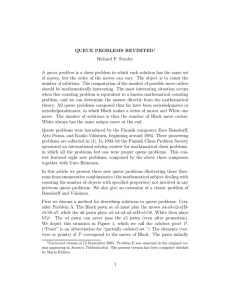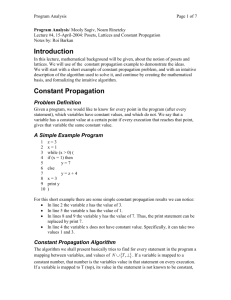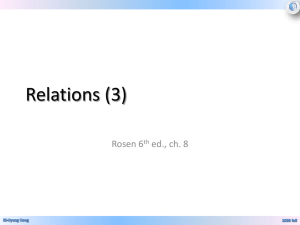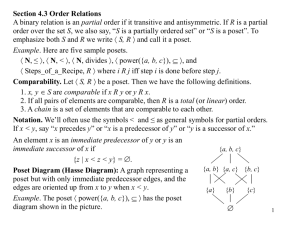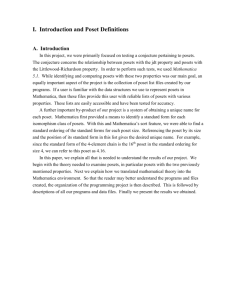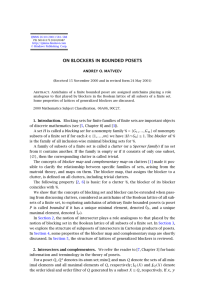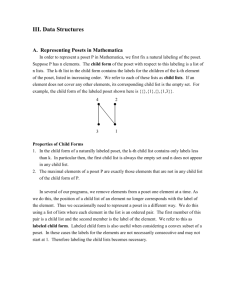Document 10514788
advertisement
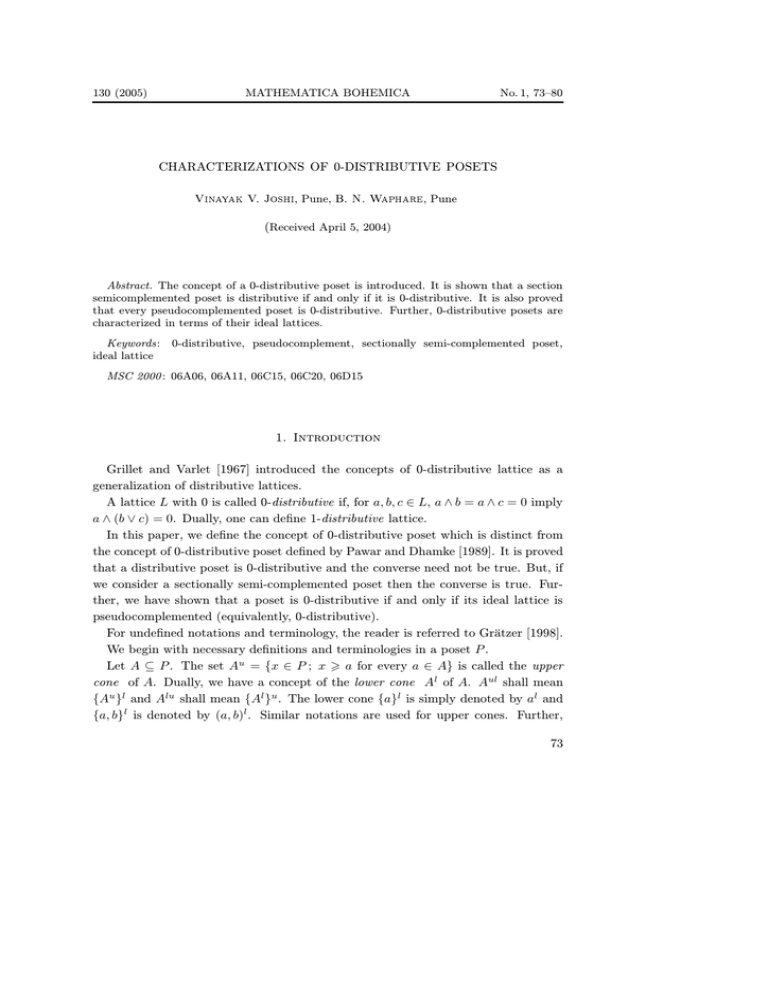
130 (2005)
MATHEMATICA BOHEMICA
No. 1, 73–80
CHARACTERIZATIONS OF 0-DISTRIBUTIVE POSETS
, Pune, , Pune
(Received April 5, 2004)
Abstract. The concept of a 0-distributive poset is introduced. It is shown that a section
semicomplemented poset is distributive if and only if it is 0-distributive. It is also proved
that every pseudocomplemented poset is 0-distributive. Further, 0-distributive posets are
characterized in terms of their ideal lattices.
Keywords:
ideal lattice
0-distributive, pseudocomplement, sectionally semi-complemented poset,
MSC 2000 : 06A06, 06A11, 06C15, 06C20, 06D15
1. Introduction
Grillet and Varlet [1967] introduced the concepts of 0-distributive lattice as a
generalization of distributive lattices.
A lattice L with 0 is called 0-distributive if, for a, b, c ∈ L, a ∧ b = a ∧ c = 0 imply
a ∧ (b ∨ c) = 0. Dually, one can define 1-distributive lattice.
In this paper, we define the concept of 0-distributive poset which is distinct from
the concept of 0-distributive poset defined by Pawar and Dhamke [1989]. It is proved
that a distributive poset is 0-distributive and the converse need not be true. But, if
we consider a sectionally semi-complemented poset then the converse is true. Further, we have shown that a poset is 0-distributive if and only if its ideal lattice is
pseudocomplemented (equivalently, 0-distributive).
For undefined notations and terminology, the reader is referred to Grätzer [1998].
We begin with necessary definitions and terminologies in a poset P .
Let A ⊆ P . The set Au = {x ∈ P ; x > a for every a ∈ A} is called the upper
cone of A. Dually, we have a concept of the lower cone Al of A. Aul shall mean
{Au }l and Alu shall mean {Al }u . The lower cone {a}l is simply denoted by al and
{a, b}l is denoted by (a, b)l . Similar notations are used for upper cones. Further,
73
for A, B ⊆ P , {A ∪ B}u is denoted by {A, B}u and for x ∈ P , the set {A ∪ {x}}u
is denoted by {A, x}u . Similar notations are used for lower cones. We note that
Alul = Al , Aulu = Au and {au }l = {a}l = al . Moreover, A ⊆ Aul and A ⊆ Alu . If
A ⊆ B then B l ⊆ Al and B u ⊆ Au .
2. 0-distributive posets
The concept of 0-distributive lattices is introduced by Grillet and Varlet [1967]
which is further extended by Varlet [1972] and also by Pawar and Thakare [1978] to
semilattices; see also C. Jayaram [1980], Hoo and Shum [1982]. Pawar and Dhamke
[1989] extended the concept of 0-distributive semilattices to 0-distributive posets as
follows.
Definition 2.1 (Pawar and Dhamke [1989]). A poset P with 0 is called 0distributive (in the sense of Pawar and Dhamke) if, for a, x1 , . . . , xn ∈ P (n finite),
(a, xi )l = {0} for every i, 1 6 i 6 n imply (a, x1 ∨ . . . ∨ xn )l = {0} whenever
x1 ∨ . . . ∨ xn exists in P .
Now, we define the concept of 0-distributive poset as follows, without assuming
the existence of join of finitely many elements:
Definition 2.2. A poset P with 0 is called 0-distributive if, for a, b, c ∈ P ,
(a, b)l = {0} = (a, c)l together imply {a, (b, c)u }l = {0}.
2.3. From the following example it is clear that these two concepts of
0-distributivity are not equivalent.
Consider the poset depicted in Figure 1 which is 0-distributive in the sense of Pawar
and Dhamke but it is not 0-distributive in our sense. Indeed, (a, b)l = (a, c)l = {0}
but {a, (b, c)u }l 6= {0}.
a
b
c
0
Figure 1
However, if P is an atomic poset then we have:
74
Proposition 2.4. Let P be an atomic poset. If P is 0-distributive in our sense
then it is 0-distributive in the sense of Pawar and Dhamke.
!" #$#&%
. Let (a, b)l = (a, c)l = (a, d)l = {0} and assume that b ∨ c ∨ d exists. To
show that P is 0-distributive in the sense of Pawar and Dhamke, we have to show
that (a, b ∨ c ∨ d)l = {0}. Assume to the contrary that (a, b ∨ c ∨ d)l 6= {0}. Since
P is atomic, there exists an atom p ∈ P such that p ∈ (a, b ∨ c ∨ d)l . This will
imply that (p, b)l = (p, c)l = (p, d)l = {0}, as p 6 a. By 0-distributivity in our sense,
{p, (b, c)u }l = {p, (c, d)u }l = {0}. Hence, there exist elements d1 and d2 in P such
that d1 ∈ (b, c)u , d2 ∈ (c, d)u and (p, d1 )l = (p, d2 )l = {0}. By 0-distributivity in our
sense, {p, (d1 , d2 )u }l = {0}. Again there exists d3 ∈ P such that (p, d3 )l = {0} and
d3 ∈ (d1 , d2 )u . But then d3 > b, c, d and therefore d3 > b ∨ c ∨ d. Hence (p, d3 )l = {0}
gives (p, b ∨ c ∨ d)l = {0}, a contradiction to p 6 b ∨ c ∨ d. The general case follows
by induction.
2.5. The converse of Proposition 2.4 is not true. The poset depicted
in Figure 2 is finite and bounded 0-distributive in the sense of Pawar and Dhamke
but not in our sense.
1
b1
b2
b3
b4
a1
a2
a3
a4
0
Figure 2
Henceforth, a 0-distributive poset will mean 0-distributive poset in our sense.
Throughout this section, P denotes a poset with 0.
The following result gives some more examples of 0-distributive posets. For that
we need:
Definition 2.6. A poset P is said to be distributive if, for all a, b, c ∈ P ,
{(a, b)u , c}l = {(a, c)l , (b, c)l }ul holds; see Larmerová and Rachůnek [1988].
Let P be a poset with 0. An element x∗ ∈ P is said to be the pseudocomplement
of x ∈ P , if (x, x∗ )l = {0} and for y ∈ P , (x, y)l = {0} implies y 6 x∗ . A poset
75
P is called pseudocomplemented if each element of P has a pseudocomplement; see
Venkatanarasimhan [1971] (see also Halaš [1993], Pawar and Waphare [2001]).
A poset P with 0 is called sectionally semi-complemented (in brief SSC) if, for
a, b ∈ P , a 66 b, there exists an element c ∈ P such that 0 < c 6 a and (b, c)l = {0}.
Lemma 2.7. A distributive poset is 0-distributive.
!" #$#&%
. Let P be a distributive poset. Let a, b, c ∈ P be such that (a, b)l =
(a, c)l = {0}. By the distributivity of P , we have {a, (b, c)u }l = {(a, b)l , (a, c)l }ul .
But (a, b)l = (a, c)l = {0} and hence {a, (b, c)u }l = {0}. Thus P is a 0-distributive
poset.
2.8. It is well known that a 0-distributive lattice need not be distributive; see the lattice of Figure 3 which is 0-distributive but not distributive.
c
Figure 3
However, the converse of Lemma 2.7 is true in an SSC poset. Explicitly, we have:
Theorem 2.9. An SSC poset is distributive if and only if it is 0-distributive.
!" #$#&%
. Let P be an SSC poset. Moreover, assume that P is 0-distributive.
Let x ∈ {(a, b)u , c}l and y ∈ {(a, c)l , (b, c)l }u for a, b, c ∈ P . To show that P is
distributive, it is sufficient to show that x 6 y. Suppose x 66 y. As P is SSC,
there exists z ∈ P such that 0 < z 6 x and (z, y)l = {0}. Since y ∈ (a, c)lu as
well as y ∈ (b, c)lu we have (a, c)l ⊆ y l and (b, c)l ⊆ y l . This yields, after taking
intersection with z l on both sides, (z, a)l = {0} and (z, b)l = {0}, as z 6 x 6 c.
Now, by 0-distributivity of P , {z, (a, b)u }l = {0}. But since z 6 x ∈ (a, b)ul , we
have z l = {z, (a, b)u }l = {0}, a contradiction to 0 < z. The converse follows from
Lemma 2.7.
Theorem 2.10. Every pseudocomplemented poset is 0-distributive.
!" #$#&%
. Let P be a pseudocomplemented poset. Let a∗ be the pseudocomplement of a. Moreover, suppose that (a, b)l = (a, c)l = {0}. By the definition of
pseudocomplement, b 6 a∗ and c 6 a∗ , and this yields (b, c)ul ⊆ {a∗ }l . Taking
intersection with al on both sides, we get {a, (b, c)u }l = (a, a∗ )l = {0}. Thus P is a
0-distributive poset.
76
2.11. It is well known that a 0-distributive lattice need not be pseudocomplemented; see the lattice of Figure 4, which is 0-distributive but not pseudocomplemented.
For a ∈ P , we denote by {a}⊥ = {x ∈ P ; (a, x)l = {0}}. Now, we characterize
0-distributive posets in terms of ideals. Halaš [1995] defined a concept of an ideal as
follows.
Definition 2.12. A non-empty subset I of a poset P is called an ideal if a, b ∈ I
implies (a, b)ul ⊆ I.
1
1
b1
b2
b3
b4
a1
a2
a3
a4
x2
a
x1
0
0
Figure 4
Figure 5
Venkatanarasimhan [1971] also defined the concept of an ideal as follows:
A non-empty subset I of a poset P is called an ideal if, a ∈ I, b 6 a ⇒ b ∈ I and
if the least upper bound of any finite number of elements of I, whenever it exists,
belongs to I.
The subset I = {0, a, b} of the poset depicted in Figure 1 is an ideal in the sense of
Venkatanarasimhan [1971] but not in the sense of Halaš [1995], as (a, b) ul = P 6⊆ I.
But if we consider the subset I = {0, a1 , a2 , a3 } of the poset depicted in Figure 5,
then it is an ideal in the sense of Halaš [1995] but not in the sense of Venkatanarasimhan [1971], as a1 ∨ a2 ∨ a3 6∈ I.
Theorem 2.13. A poset P is 0-distributive if and only if {a}⊥ is an ideal (in the
sense of Halaš) for every a ∈ P .
!" #$#&%
.
Let x, y ∈ {a}⊥ . To show that {a}⊥ is an ideal, we have to show
ul
that (x, y) ⊆ {a}⊥ . Since x, y ∈ {a}⊥ , we get (a, x)l = (a, y)l = {0}. By 0distributivity, {a, (x, y)u }l = {0}. Let z ∈ (x, y)ul . Then clearly, (a, z)l = {0}. Thus
z ∈ {a}⊥ which gives (x, y)ul ⊆ {a}⊥ . Therefore {a}⊥ is an ideal.
77
Conversely, suppose that {a}⊥ is an ideal for every a ∈ P . To show P is 0distributive, let’s assume that (a, x)l = (a, y)l = {0} for x, y ∈ P . Since (a, x)l =
(a, y)l = {0} we have x, y ∈ {a}⊥ . Since {a}⊥ is an ideal, we have (x, y)ul ⊆ {a}⊥ .
Taking intersection with al on both sides, we get {a, (x, y)u }l ⊆ {a}⊥ ∩ al . Clearly,
{a}⊥ ∩ al = {0}. Therefore {a, (x, y)u }l = {0} and the 0-distributivity of P follows.
For any subset A of P , we denote by A⊥ = {x ∈ P ; (a, x)l = {0} for all a ∈ A}.
T
It is clear that A⊥ =
{a}⊥.
a∈A
The following corollary is an easy consequence of Theorem 2.13.
Corollary 2.14. A poset P is 0-distributive if and only if A⊥ is an ideal for any
subset A of P .
The results similar to Theorem 2.13 and Corollary 2.14 are also obtained by Pawar
and Dhamke [1989] but they have considered the definition of ideal given by Venkatanarasimhan [1971].
2.15. It is well-known that the ideal lattice of a distributive lattice
is pseudocomplemented; see Varlet [1968]. However, the converse is not true; see
the lattice depicted in Figure 4 which is not distributive but whose ideal lattice is
pseudocomplemented. This example is due to Varlet [1968]. Further, Varlet [1968]
proved that a bounded below lattice is 0-distributive if and only if its ideal lattice
is pseudocomplemented. It is proved that the set of ideals (in the sense of Halaš)
of a poset P , denoted by Id(P ), forms a complete lattice under inclusion; see Halaš
[1995].
Now, we characterize 0-distributive posets in terms of their ideal lattice.
Theorem 2.16. A poset P is 0-distributive if and only if Id(P ) is pseudocomplemented.
!" #$#&%
. Let P be a 0-distributive poset and A ∈ Id(P ). By Corollary 2.14, A⊥
is an ideal in P . We claim that A⊥ is the pseudocomplement of A in Id(P ). Clearly,
A ∧ A⊥ = (0]. Assume that A ∧ B = (0] for B ∈ Id(P ). To show that A⊥ is the
pseudocomplement of A, we have to show that B 6 A⊥ . Let b ∈ B. If t ∈ (a, b)l for
some a ∈ A, then clearly t ∈ A as well as t ∈ B; hence t ∈ A ∧ B = (0]. Therefore
(a, b)l = {0} for every a ∈ A. Thus b ∈ A⊥ and we get B 6 A⊥ as required.
Conversely, suppose that Id(P ) is pseudocomplemented. To show P is 0distributive, assume that (a, x)l = (a, y)l = {0}. Hence (a] ∧ (x] = (a] ∧ (y] = (0].
Since Id(P ) is pseudocomplemented, we have (x] 6 (a]∗ and (y] 6 (a]∗ . Thus we are
78
led to (x] ∨ (y] 6 (a]∗ . Taking meet with (a], we get ((x] ∨ (y]) ∧ (a] = (a] ∧ (a]∗ = (0]
yielding {(x, y)u , a}l = {0}. Thus P is a 0-distributive poset.
Theorem 2.17. A poset P is 0-distributive if and only if Id(P ) is a 0-distributive
lattice.
!" #$#&%
. Suppose P is 0-distributive. By Theorem 2.16 and Theorem 2.10, Id(P )
is 0-distributive.
Conversely, suppose that Id(P ) is a 0-distributive lattice. To show P is 0distributive, let (a, x)l = (a, y)l = {0}. That means (a] ∧ (x] = (a] ∧ (y] = (0]. By
0-distributivity of Id(P ), (a] ∧ ((x] ∨ (y]) = (0], i.e., {a, (x, y)u }l = {0}. Hence P is
a 0-distributive poset.
Now, we add one more characterization of 0-distributivity which is even new in
the lattice context.
Theorem 2.18. A poset P with 0 is 0-distributive if and only if it satisfies the
following condition D0 .
(D0 ) If (a, b)l = (a, c)l = {0} and (a, b)ul ⊆ (b, c)ul for a, b, c ∈ P then a = 0.
!" #$#&%
.
Let P be a 0-distributive poset. To prove the condition (D0 ), assume a, b, c, ∈ P are such that (a, b)l = (a, c)l = {0} and (a, b)ul ⊆ (b, c)ul . By
0-distributivity, we have {a, (b, c)u }l = {0}. Since (a, b)ul ⊆ (b, c)ul , we get {0} =
{a, (b, c)u }l ⊇ {a, (a, b)u }l = al . Thus a = 0.
Conversely, suppose the condition (D0 ) holds. To prove that P is 0-distributive,
let a, b, c ∈ P be such that (a, b)l = (a, c)l = {0}. Let d ∈ {a, (b, c)u }l . Then clearly
(d, b)l = (d, c)l = {0} and (d, b)ul ⊆ (b, c)ul and (d, c)ul ⊆ (b, c)ul . By the condition
(D0 ), d = 0 which yields {a, (b, c)u }l = {0}.
Corollary 2.19. A lattice L with 0 is 0-distributive if and only if it satisfies the
following condition D0 .
(D0 ) If a ∧ b = a ∧ c = 0 and a ∨ b 6 b ∨ c for a, b, c ∈ L then a = 0.
')( $*+#-,/.0-1
2&3*$4
. The authors are grateful to the learned referee for many
fruitful suggestions.
79
References
[1] G. Grätzer: General Lattice Theory. Birkhäuser, New York, 1998.
[2] P. A. Grillet, J. C. Varlet: Complementedness conditions in lattices. Bull. Soc. Roy. Sci.
Liège 36 (1967), 628–642.
[3] R. Halaš: Pseudocomplemented ordered sets. Arch. Math. (Brno) 29 (1993), 153–160.
[4] R. Halaš: Annihilators and ideals in distributive and modular ordered sets. Acta Univ.
Palacki. Olomuc. Fac. Rerum Natur. Math. 34 (1995), 31–37.
[5] C. S. Hoo, K. P. Shum: 0-Distributive and P -uniform semilattices. Canad. Math. Bull.
25 (1982), 317–324.
[6] C. Jayaram: Complemented semilattices. Math. Semin. Notes, Kobe Univ. 8 (1980),
259–267.
[7] J. Larmerová, J. Rachůnek: Translations of distributive and modular ordered sets. Acta
Univ. Palacki. Olomuc. Fac. Rerum Natur. Math. 27 (1988), 13–23.
[8] M. M. Pawar, B. N. Waphare: On Stone posets and strongly pseudocomplemented
posets. J. Indian Math. Soc. (N.S.) 68 (2001), 91–95.
[9] Y. S. Pawar, V. B. Dhamke: 0-distributive posets. Indian J. Pure Appl. Math. 20 (1989),
804–811.
[10] Y. S. Pawar, N. K. Thakare: 0-distributive semilattices. Canad. Math. Bull. 21 (1978),
469–475.
[11] J. C. Varlet: A generalization of the notion of pseudo-complementedness. Bull. Soc. Roy.
Sci. Liège 37 (1968), 149–158.
[12] J. C. Varlet: Distributive semilattices and Boolean lattices. Bull. Soc. Roy. Sci. Liège 41
(1972), 5–10.
[13] P. V. Venkatanarasimhan: Pseudo-complements in posets. Proc. Amer. Math. Soc. 28
(1971), 9–17.
Authors’ addresses: Vinayak V. Joshi, Department of Mathematics, Government College of Engineering, Pune 411 005, India, e-mail: vinayakjoshi111@yahoo.com; B. N. Waphare, Department of Mathematics, University of Pune, Pune 411 007, India, e-mail:
bnwaph@math.unipune.ernet.in.
80

